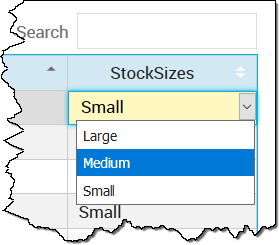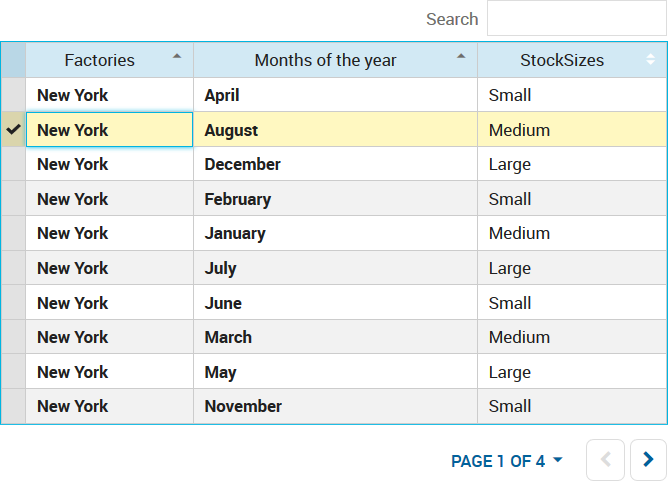Using Tables to Select, Navigate and Edit Data
Of all of the elements that might be present in views, tables are one of the most versatile, rendering a region built up from rows and columns of data. Individual table cells can be either read-only or they can be editable.
Xpress Insight tables offer a spreadsheet-style range of keyboard and mouse interactions for cell selection, navigation and editing.
When you begin interacting with a table, the first cell you click is known as the active cell and becomes an initial selection identified by its blue border and pale yellow background. You can change the active cell by clicking on another cell or navigating with the tab or arrow keys. If you press Enter while in an active, non-editable cell, the active cell switches to the next cell below it, or to the topmost non-header cell of the next column if the cell was in the bottom row.
Just click on a simple editable cell and start typing to change or replace its contents. Pressing Enter validates your changes and commits them - if the validation fails, the active cell remains where it is and a dismissible validation error dialog appears. Pressing Enter while in a read-only cell just advances the active cell as described above.

An In-cell Drop-down Editor
In this situation, make your choice and press Enter to commit your edit and move on to the next cell. If you know that a cell requires such a special in-cell editor, you can access it immediately by double-clicking in that cell.
More About Selecting Cells
You can use the mouse to create or modify selections - click and drag to create a block selection of cells, SHIFT+click to create a new block selection of cells, enlarging or contracting the previous selection. Larger selections than single-cell selections must be contiguous blocks of cells, and the active cell must remain within any possible larger selection.
As well as single cells and block selections, you can select single rows or single columns.

Selecting a Table Row
Key Combinations
| Key combination | Result |
|---|---|
| Any letter or number | Replaces contents of the cell with that letter or number |
| Arrow keys | Single active cell is moved (and first committed if the cell is edited) |
| SHIFT+arrow keys | Selection is expanded or contracted |
| ENTER | Commits save and advances active cell |
| SHIFT+ENTER | Commits save and moves active cell backwards |
| CTRL+A | Select all |
| CTRL+C | Copy selection |
| CTRL+U | Undo |
| CTRL+V | Paste |
| CTRL+ENTER | Commits save and retains active cell |
| Delete | Clears cell contents and goes into edit mode |
| Home/End | Select top left/bottom right cell |
| PageUp/PageDown | Move page up or down |
| TAB | Commits save and moves active cell horizontally to the right |
| SHIFT+Home/End | Select block from current cell to top left/right bottom cell |
| SHIFT+PageUp/PageDown | Select page up or down |
| SHIFT+TAB | Commits save and moves active cell horizontally to the left |
| ESC | Cancels any in-progress edit and retains active cell |
© 2001-2020 Fair Isaac Corporation. All rights reserved. This documentation is the property of Fair Isaac Corporation (“FICO”). Receipt or possession of this documentation does not convey rights to disclose, reproduce, make derivative works, use, or allow others to use it except solely for internal evaluation purposes to determine whether to purchase a license to the software described in this documentation, or as otherwise set forth in a written software license agreement between you and FICO (or a FICO affiliate). Use of this documentation and the software described in it must conform strictly to the foregoing permitted uses, and no other use is permitted.

